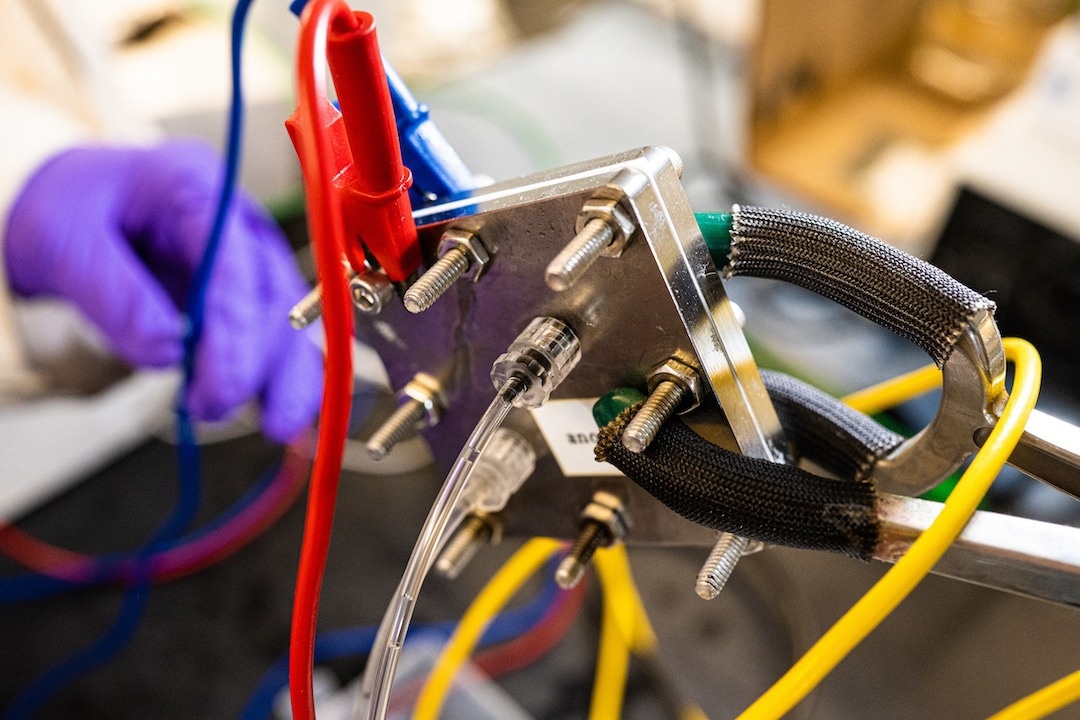Developing a hydrogen economy is no easy endeavor; however, Rice University engineers have identified a mechanism that could make oxygen evolution catalysis in acids, one of the most difficult problems in water electrolysis for producing clean hydrogen fuels, more cost-effective and practical.

An experimental reactor at Rice employs a ruthenium-based anode to split water into hydrogen and oxygen without the need for expensive iridium. Image Credit: Jeff Fitlow.
Haotian Wang’s lab at Rice’s George R. Brown School of Engineering has substituted rare and expensive iridium as the positive-electrode catalyst in a reactor that splits water into hydrogen and oxygen with ruthenium, a far more ubiquitous precious metal.
The effective addition of nickel to ruthenium dioxide (RuO2) by the lab culminated in a strong anode catalyst that generated hydrogen from water electrolysis for thousands of hours at ambient conditions.
There’s huge industry interest in clean hydrogen. It’s an important energy carrier and also important for chemical fabrication, but its current production contributes a significant portion of carbon emissions in the chemical manufacturing sector globally. We want to produce it in a more sustainable way, and water-splitting using clean electricity is widely recognized as the most promising option.
Haotian Wang, George R. Brown School of Engineering, Rice University
Iridium, according to Wang, is eight times more expensive than ruthenium and might add 20% to 40% to the price of manufacturing commercial devices, especially for future large-scale deployments.
In the journal Nature Materials, Wang, Rice postdoctoral associate Zhen-Yu Wu, graduate student Feng-Yang Chen, and associates from the Universities of Pittsburgh and Virginia detailed their procedure.
The development of oxygen and hydrogen that occurs when polarized catalysts rearrange water molecules to release oxygen and hydrogen is referred to as “water splitting.”
Wu states, “Hydrogen is produced by the cathode, which is a negative electrode. At the same time, it has to balance the charge by oxidizing water to generate oxygen on the anode side.”
The cathode is very stable and not a big problem, but the anode is more prone to corrosion when using an acidic electrolyte. Commonly used transition metals like manganese, iron, nickel and cobalt get oxidized and dissolve into the electrolyte. That’s why the only practical material used in commercial proton exchange membrane water electrolyzers is iridium. It’s stable for tens of thousands of hours, but it’s very expensive.
Feng-Yang Chen, Graduate Student, Rice University
In an effort to identify a replacement, Wang’s lab looked into numerous metals before deciding on ruthenium dioxide for its well-known activity and doping it with nickel.
Authors demonstrated that ultrasmall, highly crystalline RuO2 nanoparticles with nickel dopants at the anode supported water splitting for more than 1,000 hours at a current density of 200 milliamps per square centimeter without degrading.
They contrasted their anodes to those constructed of pure ruthenium dioxide, which facilitated water electrolysis for a limited number of hours before decomposing.
To enable application in current commercial processes, the lab is working to develop its ruthenium catalyst.
Now that we’ve reached this stability milestone, our challenge is to increase the current density by at least five to 10 times while still maintaining this kind of stability. This is very challenging, but still possible.
Haotian Wang, George R. Brown School of Engineering, Rice University
Wang considers the necessity to be pressing.
Wang concludes, “The annual production of iridium won’t help us to produce the amount of hydrogen we need today. Even using all the iridium globally produced will simply not generate the amount of hydrogen we will need if we want it to be produced via water electrolysis. That means we can’t fully rely on iridium. We have to develop new catalysts to either reduce its use or eliminate it from the process entirely.”
Haotian Wang is the William Marsh Trustee Chair at Rice and an assistant professor of chemical and biomolecular engineering.
The study was supported by the Welch Foundation (C-2051-20200401), the David and Lucile Packard Foundation (2020–71371), a Roy E. Campbell Faculty Development Award, the National Science Foundation (1905572, 2004808), the University of Pittsburgh Center for Research Computing and the Advanced Photon Source of Argonne National Laboratory.
Journal Reference:
Wu, Z.-Y., et al. (2022) Non-iridium-based electrocatalyst for durable acidic oxygen evolution reaction in proton exchange membrane water electrolysis. Nature Materials. doi.org/10.1038/s41563-022-01380-5.